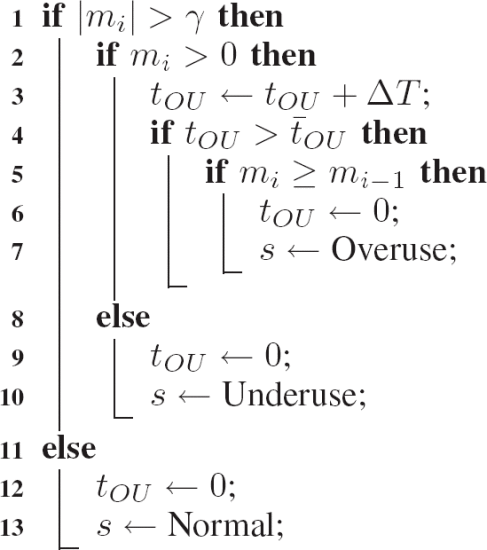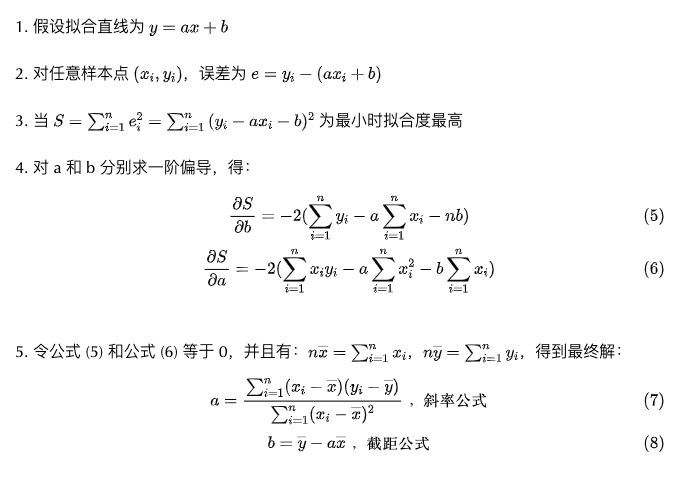Transport-wide Congestion Control
Abstract |
RTP Extensions for Transport-wide Congestion Control |
Authors |
Walter Fan |
Status |
WIP |
Updated |
2024-08-21 |
概述
TWCC 属于 GCC(Google Congestion Control ) 的第二版, 相对于第一版,它做了如下改进
接收端只做反馈,所有的探测和估算逻辑都放在发送端
将第一版中使用的 Kalman Filter 改为 Trendline Filter
带宽估算中综合考虑带宽探测的码率,确认收到的流量码率,基于丢包和基于延迟所估算的码率
这样做的好处在于
The congestion control algorithms are easier to maintain and improve as there is less synchronization between sender and receiver versions needed.
2) More flexibility in what algorithms are used, as long as they are having most of their logic on the send-side. For instance different behavior can be used depending on if the rate produced is application limited or not.
It is a better fit for congestion control as the congestion controller doesn’t operate on media streams, but on packet flows.
It allows for earlier packet loss detection (and recovery) since a loss in stream A can be detected when a packet from stream B is received, thus we don’t have to wait until the next packet of stream A is received.
Inter-packet delay variation: d(i) = A(i) - S(i) - (A(i-1) - S(i-1))
扩展
Transport wide sequence numbers header extension 在 RTP 包中添加一个扩展头,放置传输层面的序号
SDP
a=extmap:5 http://www.ietf.org/id/draft-holmer-rmcat-transport-wide-cc-extensions-01
Transport Feedback 增加一个 RTCP 反馈消息,用来反馈接收到的数据包及其延迟的信息 RTCP-Transport-FB 默认发送频率 1time/100ms,同时其动态适应使用 5%的可用带宽,最大频率值为 1time/50ms、最小频率值为 1time/250ms。以 1time/100ms 的频率发送,其最大需要耗费 16kbps 带宽
a=rtcp-fb:100 transport-cc
Transport-wide Sequence Number
在每个要发送的 RTP 包中添加一个扩展头,包含 16 bits 的序号 sequence number. 在同一个传输通道中,每发一个 RTP 包,这个序号就加一
0 1 2 3
0 1 2 3 4 5 6 7 8 9 0 1 2 3 4 5 6 7 8 9 0 1 2 3 4 5 6 7 8 9 0 1
+-+-+-+-+-+-+-+-+-+-+-+-+-+-+-+-+-+-+-+-+-+-+-+-+-+-+-+-+-+-+-+-+
| 0xBE | 0xDE | length=1 |
+-+-+-+-+-+-+-+-+-+-+-+-+-+-+-+-+-+-+-+-+-+-+-+-+-+-+-+-+-+-+-+-+
| ID | L=1 |transport-wide sequence number | zero padding |
+-+-+-+-+-+-+-+-+-+-+-+-+-+-+-+-+-+-+-+-+-+-+-+-+-+-+-+-+-+-+-+-+
Transport-wide RTCP Feedback Message
0 1 2 3
0 1 2 3 4 5 6 7 8 9 0 1 2 3 4 5 6 7 8 9 0 1 2 3 4 5 6 7 8 9 0 1
+-+-+-+-+-+-+-+-+-+-+-+-+-+-+-+-+-+-+-+-+-+-+-+-+-+-+-+-+-+-+-+-+
|V=2|P| FMT=15 | PT=205 | length |
+-+-+-+-+-+-+-+-+-+-+-+-+-+-+-+-+-+-+-+-+-+-+-+-+-+-+-+-+-+-+-+-+
| SSRC of packet sender |
+-+-+-+-+-+-+-+-+-+-+-+-+-+-+-+-+-+-+-+-+-+-+-+-+-+-+-+-+-+-+-+-+
| SSRC of media source |
+-+-+-+-+-+-+-+-+-+-+-+-+-+-+-+-+-+-+-+-+-+-+-+-+-+-+-+-+-+-+-+-+
| base sequence number | packet status count |
+-+-+-+-+-+-+-+-+-+-+-+-+-+-+-+-+-+-+-+-+-+-+-+-+-+-+-+-+-+-+-+-+
| reference time | fb pkt. count |
+-+-+-+-+-+-+-+-+-+-+-+-+-+-+-+-+-+-+-+-+-+-+-+-+-+-+-+-+-+-+-+-+
| packet chunk | packet chunk |
+-+-+-+-+-+-+-+-+-+-+-+-+-+-+-+-+-+-+-+-+-+-+-+-+-+-+-+-+-+-+-+-+
. .
. .
+-+-+-+-+-+-+-+-+-+-+-+-+-+-+-+-+-+-+-+-+-+-+-+-+-+-+-+-+-+-+-+-+
| packet chunk | recv delta | recv delta |
+-+-+-+-+-+-+-+-+-+-+-+-+-+-+-+-+-+-+-+-+-+-+-+-+-+-+-+-+-+-+-+-+
. .
. .
+-+-+-+-+-+-+-+-+-+-+-+-+-+-+-+-+-+-+-+-+-+-+-+-+-+-+-+-+-+-+-+-+
| recv delta | recv delta | zero padding |
+-+-+-+-+-+-+-+-+-+-+-+-+-+-+-+-+-+-+-+-+-+-+-+-+-+-+-+-+-+-+-+-+
version (V): 2 bits This field identifies the RTP version. - RTP 的版本,当前版本都是 2.
padding (P): 1 bit If set, the padding bit indicates that the packet contains additional padding octets at the end that are not part of the control information but are included in the length field. - 指示是否有填充内容
feedback message type (FMT): 5 bits This field identifies the type of the FB message. It must have the value 15. ** - 反馈消息类型, 根据RFC4585 的定义,值为 15, 含义是 Application layer FB (AFB) message 应用层反馈消息**
payload type (PT): 8 bits This is the RTCP packet type that identifies the packet as being an RTCP FB message. The value must be RTPFB = 205. - 荷载类型,根据RFC4585 的定义,值为 205,含义是Transport layer FB message 传输层反馈消息
SSRC of packet sender: 32 bits The synchronization source identifier for the originator of this packet. - 这个反馈消息包发起者的同步源标识
SSRC of media source: 32 bits The synchronization source identifier of the media source that this piece of feedback information is related to. TODO: This is transport wide, do we just pick any of the media source SSRCs? - 这个反馈消息包对应的媒体流的同步源标识,这个值待确定,因为这是一个传输通道范围的反馈,这个值必要性不大,可以随意选取一个 media SSRC
base sequence number: 16 bits The transport-wide sequence number of the first packet in this feedback. This number is not necessarily increased for every feedback; in the case of reordering it may be decreased. - 该 fb 包首个 rtp 包的 transport seq,非 rtp 包序列号。
packet status count: 16 bits The number of packets this feedback contains status for, starting with the packet identified by the base sequence number. - 该 fb packet 包含 rtp 包个数。
reference time: 24 bits Signed integer indicating an absolute reference time in some (unknown) time base chosen by the sender of the feedback packets. The value is to be interpreted in multiples of 64ms. The first recv delta in this packet is relative to the reference time. The reference time makes it possible to calculate the delta between feedbacks even if some feedback packets are lost, since it always uses the same time base. - 参考时间,fb 包首个 rtp 的到达时间/64
feedback packet count: 8 bits A counter incremented by one for each feedback packet sent. Used to detect feedback packet losses. - 已发送 feedback 包计数器,可用于 fb packet 丢失检测
packet chunk: 16 bits A list of packet status chunks. These indicate the status of a number of packets starting with the one identified by base sequence number. See below for details. ** - 描述 rtp 包 4 种状态(见:4.2),有 Run Length Chunk 和 Status Vector Chunk 两种格式**
recv delta: 8 bits For each "packet received" status, in the packet status chunks, a receive delta block will follow. See details below. - 当 rtp 包的状态为 Packet received,通过 recv delta 记录其与前一个 rtp 包到达的时间间隔。
Rtp Packet Status
包的状态 (Packet Status) 表示为 2 个比特的符号:
00 Packet not received (包未收到)
01 Packet received, small delta (包收到,间隔时间很小 )
10 Packet received, large or negative delta( 包收到,间隔时间很大或者为负数)
11 [Reserved], packet received, w/o recv delta (包收到了,但是没有间隔时间)
Packet chunk
packet chunk 对 rtp 的到达状态进行描述,它有两种类型
Run Length Chunk
Status Vector Chunk
通过第一个比特位标识了是哪种类型
0 :Run Length Chunk
1 :Status Vector Chunk
Run Length Chunk
0 1
0 1 2 3 4 5 6 7 8 9 0 1 2 3 4 5
+-+-+-+-+-+-+-+-+-+-+-+-+-+-+-+-+
|T| S | Run Length |
+-+-+-+-+-+-+-+-+-+-+-+-+-+-+-+-+
字段含义如下
T (1 bit) : chunk type,当为 Run Length Chunk ,此时值为 0。
S (1 bit) :packet status symbo,2 bits ,表示包的到达状态
Run Length (13 bit) :表示多少个连续包的状态
例 1:
0 1
0 1 2 3 4 5 6 7 8 9 0 1 2 3 4 5
+-+-+-+-+-+-+-+-+-+-+-+-+-+-+-+-+
|0|0 0|0 0 0 0 0 1 1 0 1 1 1 0 1|
+-+-+-+-+-+-+-+-+-+-+-+-+-+-+-+-+
00 代表包未收到 "packet not received" 后面13个比特值为 221,表示221个包未收到
例 2:
0 1
0 1 2 3 4 5 6 7 8 9 0 1 2 3 4 5
+-+-+-+-+-+-+-+-+-+-+-+-+-+-+-+-+
|0|1 1|0 0 0 0 0 0 0 0 1 1 0 0 0|
+-+-+-+-+-+-+-+-+-+-+-+-+-+-+-+-+
11 代表 "packet received, w/o recv delta" ,共有 24 个包,不过没有间隔时间数据
Status Vector Chunk
0 1
0 1 2 3 4 5 6 7 8 9 0 1 2 3 4 5
+-+-+-+-+-+-+-+-+-+-+-+-+-+-+-+-+
|T|S| symbol list |
+-+-+-+-+-+-+-+-+-+-+-+-+-+-+-+-+
T(1 bit): chunk type, 当为 Status Vector Chunk ,此时值为 1。
S(1 bit): symbol size 符号长度,0 表示符号长度为 14, 1 表示符号长度为 7
Symbol list(14 bits),符号表,描述了 x 个包的到达状态,x 的数量取决于 S 的值, - 当 S = 0 时 x = 14,每个符号为 1 个比特, 0 代表没收到,1 代表收到了 - 当 S = 1 时 x = 7, 每个符号为 2 个比特, 00,01,10,11 表示包的状态
例 1:
这块数据中 S = 0 ,包含了 14 个包的状态,用 14 个比特位描述, 0 代表没收到,1 代表收到了
1x "packet not received" - 第一个包没收到
5x "packet received" - 之后 5 个包收到了
3x "packet not received" - 之后 3 个包没收到
3x "packet received" - 之后 3 个包收到了
2x "packet not received" - 之后 2 个包没收到
例 2:
这块数据中 S = 1 ,包含了 7 个包的状态,每个包用 2 个比特来描述
1x "packet not received"
1x "packet received, w/o timestamp"
3x "packet received"
2x "packet not received"
Receive Delta
Receive Delta 长度为一个字节或两个字节, 记录每个包与之前收到的包的间隔时间, 它是 250us 的倍数 因为 reference_time 是当前包组第一个 packet 到达的时间,, 所以:
1st arrive_time = reference_time + receive_delta
2nd arrtive_time = 1st arrive_time + receive_delta
当包的状态为 Packet received,此时 fb packet 会通过 Receive Delta 记录其与前一个 RTP 包到达时间的间隔,单位是 250us.
当状态是 “Packet received, small delta”,用 8-bit unsigned 存储 delta, 附加在 packet status list 之后, 此时 delta 取值为 [0,255] * 250 , 表示范围为 [0, 63.75] ms.
当状态是 “Packet received, large or negative delta”,用 16-bit signed 存储 delta,附加在 packet status list 之后, 此时 delta 取值为 [-32767, 32768] * 250, 表示范围为 [-8192.0, 8191.75] ms.
如果间隔时间太大,就需要启用使用新的 RTCP feedback 包了,不过一般也不会有这么大的延迟,除非网络中断了。
基于延迟的发送端拥塞控制
发送端带宽估计的基本框架和之前版本的接收端的框架类似
Pre-filtering: 过滤掉当网络发生中断或一些突发情况
Arrival-time filter: 采用卡尔曼滤波或趋势线滤波
Over-use detector: 与预设的阈值进行比较, 检测是否有拥塞
Rate control : 进行发送速率的调整, 可采用 TCP 中使用的 AIMD(加增乘减法)

基本方法
发送端为每个 RTP 包添加 transport wide sequence number 扩展头, 它是一个传输通道范围的序号
发送端保存这个序号和相应的发送时间 send_time
接收端记录 RTP 包的到达状态 packet status(是否到达,到达时间),并构造一个 transport wide cc RTCP feedback 消息, 发回给发送方
发送端将这些 RTP 包的发送时间 send_time, 到达时间 arrive_time 取出来, 并将它们分组(以 5ms 长度)
发送端计算 group one way delay variant 包组的单向延迟变化
g_i: the last packet arriving time of i-th packet group
G_i: the first packet sending time of i-th packet group
recv_delta_ms = g_i - g_{i-1}
send_delta_ms = G_i - G_{i-1}
delta_ms = recv_delta_ms - send_delta_ms
计算累计延迟变化
将累积延迟变化进行指数平滑 exponential backoff filter
以到达时间为横轴, 延迟变化为纵轴进行线性回归, 计算其拟合出的趋势线的斜率 slope
x 轴为 arrive_time_ms_i, 并不是第 i 个包组的到达时间, 而是 第 i 个包组最后一个包的到达时间减去第一个包组的最后一个包的到达时间 y 轴为 smoothed_delay_ms_i, 即上而算出的平滑累计延迟变化
将计算出来的斜率与一个动态阈值进行比较, 来发现通道是否有拥塞
每次接收到视频帧 \(t_i\) 时,过度使用检测器都会产生一个信号 s,该信号基于排队延迟梯度 \(m(t_i)\) 和阈值 \(\gamma\) 来驱动 FSM (下面的有限状态机) 的状态 \(\sigma\),算法 1 详细显示了 s 是如何生成的 :
当 \(m(t_i) > \gamma\) 时,算法通过增加帧间隔时间 \(\Delta T\) 的变量 \(t_{OU}\) 来跟踪在这种情况下花费的时间。 当 \(t_{OU}\) 达到 \(\bar{t}_{OU}=100ms\) 且 \(m(t_i) > m(t_{i-1})`\) 时,产生过度使用信号。
另一方面,如果 \(m(t_i)\) 减小到 \(\gamma\) 以下,则产生未充分利用信号,而当 \(-\gamma \leq m(t_i) \leq \gamma\) 时触发正常信号。

remote rate controller finite state machine
算法: Over-use Detector pseudo-code 过度使用检测器的伪代码

over-use detector pseudo code
根据以上的检测结果, 调整发送速率, GCC 采用 AIMD 算法
AIMD 算法来源于 TCP 协议,参见 https://en.wikipedia.org/wiki/Additive_increase/multiplicative_decrease
速率控制分为两部分,
根据延迟 delay 来调整带宽估计,或称发送速率
根据丢包 loss 来调整带宽估计,或称发送速率
最终会综合比较 \(A_d\) 和 \(A_l\), 即两者之间的一个最小值此
以下为其状态转换图, 空白单元表示维持当前状态
+----+--------+-----------+------------+--------+
| \ State | Hold | Increase |Decrease|
| \ | | | |
| Signal\ | | | |
+--------+----+-----------+------------+--------+
| Over-use | Decrease | Decrease | |
+-------------+-----------+------------+--------+
| Normal | Increase | | Hold |
+-------------+-----------+------------+--------+
| Under-use | | Hold | Hold |
+-------------+-----------+------------+--------+
其他算法细节
动态阈值的生成
为避免路由队列过小或由于并发的TCP flow 竞争所造成的饥饿, 这个阈值的设置很关键. 阈值如果太小会对于网络的瞬时干扰过于敏感, 如果太大则会反应太迟钝, 很难设置一个合适的值. GCC v2 采用了一种在 GCC v1 中定义的自适应的阈值 Adaptive threshold
这里的 \(\Delta T\) 是指 \(t_i - t_{i-1}\), \(t_i\) 是第 i-th 包到达的时间
\(\gamma(t_i)\) 代表阈值 \(m(t_i)\) 代表趋势斜率 \(k_\gamma\) 代表阈值调整系数, 定义如下:
在 GCC 草案中 \(k_d\) 取值为 0.00018, \(k_u\) 取值为 0.01
指数平滑算法和最小二乘法
通过对接收和发送的延迟的变化,计算拥塞延迟的变化趋势的斜率 (slope), 用到了指数平滑算法和最小二乘法
EWMA(Exponentially Weighted Moving Average )
EWMA 指数加权移动平滑法(Exponential Smoothing) 是在移动平均法基础上发展起来的一种时间序列分析预测法.
具体解释参见 https://www.itl.nist.gov/div898/handbook/pmc/section4/pmc431.htm
最小二乘法(Least Squars Method)

更多代码分析参见 GCC 拥塞控制的实现